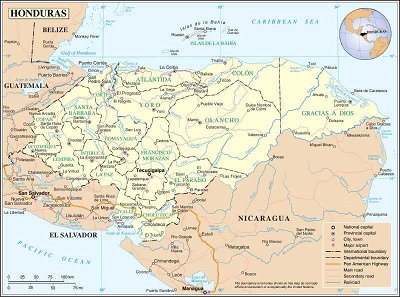24. Honduras contains one of the richest archaeological sites in the Americas in the ruins of the city of Copan. What ancient civilization built this beautiful and important site?
From Quiz Hola, Honduras
Answer:
Mayan
Copan is in the western corner of the country, near to Guatemala. It is believed that by 200 AD a community had formed in the Copan valley but the people were not as advanced as were the Mayans. In 426, a prince arrived from Mexico, took control of the city, and founded a Mayan dynasty. By the 800s a great town of 20,000 people with large, magnificent, ceremonial buildings, temples and works of art stood in the Copan valley. These people were successful in architecture, mathematics, astronomy and sculpture, but they didn't do as well in the use and conservation of their land, keeping the peace, or keeping their people healthy.
The problem of feeding their growing population became worse and they used more slash and burn methods to try to grow more food, depleting the nutrients in the land. In the meantime, the elite of the town were building their houses on the river banks, the logical place to plant harvestable crops. Scientists have shown that the people were malnourished and sickly, as well as dying younger than had earlier generations, probably from their lack of growing enough food. To add to their problems, unlike other societies such as the Incans, they did not form a union or confederacy but remained independent city-states. As such, they warred with other Mayan cities, trying to conquer and control one another. Finally, a neighboring city that had been under Copan's control for too long rose up and killed Copan's head man, causing Copan to slowly begin to decline. The city died out and was covered by the jungle.
Copan was found again in 1576 by a Spanish explorer and again in 1834 a general in the Honduran army, but neither of them could get any support from their people for further exploration of the site. However, an American diplomat's interest was piqued and in 1838 he spent a few weeks in Copan, eventually buying it from the farmer who owned the land for $50. After that, the explorations began in earnest and are still going on today.
In 1980 it was named a UNESCO World Heritage Site.
 Home to nine of the 25 highest mountains in Central America, Honduras has aptly earned the moniker "The Tibet of Central America". Let's explore and uncover the beauty and wonders of this mountainous nation. Enjoy!
Home to nine of the 25 highest mountains in Central America, Honduras has aptly earned the moniker "The Tibet of Central America". Let's explore and uncover the beauty and wonders of this mountainous nation. Enjoy! 






 Quick Question
Quick Question Top 20% Rated Quiz,
Top 20% Rated Quiz,